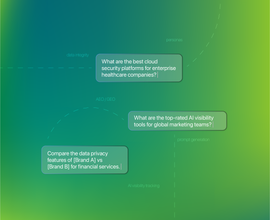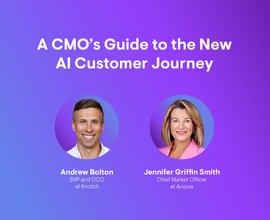AI-Generated Content: Tips, Tools, and Best Practices
AI-generated content, or AI-created content as it’s also called, is a type of computer-generated copy that can replicate human writing and thinking. AI content generators take many forms and can write entire pieces of content—like articles and social media posts—or help brainstorm by simulating human interaction in a chat. For enterprise organizations churning out content across dozens of channels, AI tools aren't just nice-to-haves anymore—they're how you keep up without burning out your team.
AI tools are everywhere in content creation, with chatbots and platforms like ChatGPT, Claude, Perplexity, and other AI engines becoming essential parts of most content creators' workflows. These tools have fundamentally changed how we approach writing, making it faster and easier to produce content at scale. Regular releases of more advanced GPT models continue to make AI more powerful and accessible.
But here's the hard truth: most people are discovering that while AI makes content creation faster, it doesn't automatically make it better. The internet is now flooded with AI-generated content that sounds remarkably similar—generic, surface-level, and not optimized for success in AI search or traditional search engines. The real challenge isn't generating content anymore; it's creating high-quality, expert-level content that actually stands out and performs.
This is where the depth of your AI strategy matters. Not all AI content tools are created equal, especially when it comes to creating content that ranks in search engines, gets cited and mentioned in AI search, and drives real business results. The difference is in whether you're using AI for quick content generation or strategic content optimization.
With AI now mainstream, the smartest content creators aren't asking whether to use it—they're asking which tools to use when. This guide will show you how to leverage AI that goes beyond basic content generation to create content that actually drives brand awareness and conversions for your business.
What is AI-generated content?
AI-generated content describes pieces of writing or designs created by generative AI (Gen AI)—artificial intelligence systems that can produce new, original content rather than just analyze existing information. These tools use machine learning based on human inputs to create anything from long-form articles to Facebook ad copy. Some tools even offer AI image generation.
Generative AI differs from earlier AI technology because it actually creates something new. Instead of simply finding patterns or classifying data, Gen AI learns from massive datasets and uses that knowledge to generate original text, images, or other content based on your prompts.
What's changed isn't AI's presence in content creation—it's the sophistication and accessibility of these tools. Although ChatGPT has gotten most of the headlines lately, there are several different kinds of AI tools that can help generate content.
Common AI content generation tools
Today's AI content tools fall into several categories, each designed for different purposes:
- Conversational AI platforms like ChatGPT, Claude, and Google Gemini excel at generating text through natural conversation. These tools are incredibly versatile but work best for ideation, first drafts, and general writing tasks.
- Answer engines like Perplexity and ChatGPT Search combine AI generation with real-time web data, making them powerful for research and fact-gathering rather than pure content creation.
- Horizontal content tools like Jasper, Writer, and Copy.ai focus specifically on marketing copy across multiple channels, offering templates and workflows for different content types.
- Vertical or enterprise AEO platforms like Conductor's Writing Assistant go beyond basic content generation by learning your brand voice and audience, then contextualizing content for your specific site performance. Unlike horizontal tools that offer cookie-cutter templates, these platforms customize content that's genuinely optimized for your business goals and search performance.
How does AI-generated content work?
At its core, AI content generation relies on large language models (LLMs) trained on massive datasets of text. These models use natural language processing (NLP) to analyze patterns in language—how words typically follow each other, how sentences are structured, and how different types of content are organized.
Natural language processing (NLP) involves training a machine learning algorithm with hundreds of datasets from books, articles, and other content to understand the nuances of language, such as grammar, syntax, and word choice. This means that when you give an AI tool a prompt, it essentially “predicts” the likelihood that different words will appear based on a user’s input text.
But here's where different tools diverge dramatically: while basic AI models work with general language patterns, vertical or enterprise AEO platforms layer comprehensive, real-time data on top. This includes current search rankingsRankings
Rankings in SEO refers to a website’s position in the search engine results page.
Learn more, competitor analysis, keywordKeyword
A keyword is what users write into a search engine when they want to find something specific.
Learn more data, brand guidelines, conversionConversion
Conversions are processes in online marketing that lead to a defined conclusion.
Learn more optimization principles, and your actual website performance—all integrated to create content that's well-written and strategically optimized for your specific business goals.
This is why the tool you choose matters more than you might think—they're all using fundamentally similar NLP technology, but what they do with that technology varies dramatically based on their specific focus and additional data resources.
Choosing the right type of AI tool
Vertical vs. horizontal AI tools
- Horizontal AI tools like ChatGPT, Claude, Jasper, and Writer are designed to work across industries and use cases. They're generalists—built to help anyone write anything, from social media posts to product descriptions to blog articles. These tools rely on broad training data and generic templates, which means they can handle a wide variety of tasks but lack the specialized context needed to create truly optimized website content. While they're useful for getting started or handling basic copywriting tasks, they don't understand your specific market, competitors, or what actually drives performance for your site.
- Vertical AI tools like Conductor's Writing Assistant are purpose-built for a specific domain—in this case, website content optimization. Instead of offering one-size-fits-all templates, these platforms integrate your actual website data, search performance metrics, competitive intelligence, and brand guidelines to create content that's strategically optimized for your business goals. They understand not just how to write, but what makes content succeed in your specific industry and search landscape.
The main difference? Horizontal tools help you write faster. Vertical tools help you write content at scale that actually performs.
Quick comparisons on AI tools
Conversational AI: ChatGPT, Claude, Gemini, Perplexity
- Best for: Quick brainstorming, first drafts, research summaries
- Not ideal for: Final website content, brand-specific messaging
Horizontal content tools: Jasper, Writer, Copy.ai
- Best for: Social media posts, ad copy, email templates across channels
- Not ideal for: SEO/AEO-optimized website content, competitive differentiation
Vertical AEO platforms: Conductor
- Best for: Website content optimized for search, brand voice consistency at scale, content informed by your actual competitive landscape, and site performance
- Not ideal for: Quick one-off tasks, general marketing copy
Why AI content generation tools have become essential
The shift happened faster than anyone expected. What started as a curiosity about AI capabilities quickly became a necessity as content demands exploded and teams stayed the same size. AI tools didn't just become popular; they became essential for creating content at the scale needed to compete.
The real breakthrough wasn't any single tool, but the realization that AI could handle the tedious, time-consuming parts of content work. Whether you're using conversational AI for initial drafts, answer engines for research, or specialized tools for optimization, these platforms excel at automating the repetitive tasks that used to eat up entire days.
Take this article, for example. AI helped with everything from initial topic and keyword research to drafting meta descriptions and generating content via Conductor Creator. However, the strategic decisions—what angle to take, how to structure the argument, and which tools to recommend—still required a human-in-the-loop approach.
What AI-generated content means for content creators
The popularity of tools like ChatGPT, Perplexity, and other AI content generators has renewed fears that AI will replace people, in this case, content marketers. While it’s true that AI tools can create an entirely new piece of content in a fraction of the time it takes a human, they do not directly replace writers or designers. Instead, it's created a new dynamic: creators who use AI strategically can create optimized content at a speed and scale that was previously impossible.
In short, don’t panic. The sky isn’t falling. In fact, this actually presents an opportunity for content creators to grow.
AI is a tool, and LLMs and content generators are invaluable tools for writers and designers. Here’s a concrete example. A guard uses cameras to keep an area secure. The cameras work autonomously but don’t replace the need for a security guard; they simply make the guard’s job easier.
An aspect of that example that you shouldn’t overlook is the fact that the cameras don’t replace the need for a security guard. A camera still needs a human to act on the information it provides, and AI-generated content is no different. No matter which tool you're using, AI tools are imperfect. Several times while writing this, Grammarly gave me suggestions that changed the meaning of sentences or made phrasing unclear. ChatGPT, Claude, Perplexity, and all of the other AI models are similar in that they sometimes offer incorrect, inaccurate, or, in some cases, harmful information, and it falls to the writers to be vigilant and correct the copy as needed.
This example follows the 30% rule, a framework practiced by many content creators: let AI handle about 70% of the heavy lifting—research, drafts, optimization—while you focus human effort on the critical 30% that requires strategic thinking, unique insights, and quality control. This balance ensures AI enhances productivity without sacrificing the expertise and judgment that make content truly valuable.
Like I said, I used Conductor's AI Writing Assistant to help with parts of this article, including generating some of the content you are reading. These tools work quickly and simplify workflows, which means they aren’t going anywhere. So the question you should be asking yourself isn’t whether AI is worth incorporating into your practices, but rather, what the best way to leverage AI is for you and your team.
Not all AI writing tools are created equal, and this report proves it. See comparisons that reveal which tools are worth your time and which fall short.
What AI-generated content means for SEOs
Like content creators or marketers, SEOs stand to benefit significantly from including AI in their workflows. While the use cases will differ, any SEO will tell you that their day-to-day is filled with tedious tasks that hurt productivity. From a workflow perspective, SEOs can use AI content and chatbot tools to automate things like keyword/topic research, pulling and organizing data, and creating title tags and meta descriptions for upcoming content.
Beyond that, AI content generators, and chatbots specifically, are great for helping to brainstorm ideas and get inspiration. For instance, you could ask ChatGPT to create a list of the 10 best marketing podcasts or the best YouTube videos on the state of the search industry, which could provide inspiration for future content topics, as well as help you expand your skills.
Benefits and limitations of AI-generated content
Like any other tool, this technology has significant benefits to help you complete tedious tasks, but also several limitations you should be aware of.
Benefits of AI-generated content
- Ease of use: Many AI models today are open to the public and, in many cases, free to use. Anyone can start using these tools right now and get answers to almost anything that comes to mind. All you need is to create an account, and you can start playing around with the technology and finding the ways it could work best for you.
- Quick turnaround time: Tools like ChatGPT, Perplexity, and Claude will provide content based on your specific inputs almost instantly, depending on the complexity of the task. ChatGPT replies to most requests within a few minutes, even to something complex. For example, I asked it to explain what a W2 form is and got a four-paragraph response in under a minute. So AI can keep even your most complex workflows more agile.
- Good source of inspiration: AI content generators are very helpful in providing ideas for your content. For instance, I could ask ChatGPT to provide me with five title options for this article, and within moments, I have a list of ideas for titles to work from and revise as needed.
Limitations of AI-generated content
Despite what you may have heard, AI can’t actually do everything. While it speeds up tedious workflows and creates content quickly, it's not without faults. In fact, the limitations of the AI tools are often listed on their sites, warning that they may occasionally provide incorrect or harmful information. Before you start leveraging these tools in your content strategy, you have to understand where they may lead you astray.
- Content doesn’t have a human touch: This is the big one, so let’s start here. It’s true that AI can create high-quality, readable content very quickly, but what it can’t do is satisfy audience search intent with consistency. We know that Google promotes helpful, high-quality content that satisfies user search intent, so providing that content will only become more important if sites start pumping out slightly different AI-generated content. Essentially, AI content generators can help provide the framework for a piece of content, but in order to really provide something unique and impactful, you will always need to devote time and effort to proofing, rewriting, and finding the heart in your content.
- The tool may hallucinate or generate incorrect information: These are ChatGPT’s own words. In the user interface, ChatGPT warns that the information the tool provides isn’t 100% accurate all the time. While we just went over how ChatGPT, Claude, Perplexity, and others can be hugely helpful research tools, it’s important to keep in mind that every once in a while, it is also prone to AI hallucinations—essentially making up information that sounds plausible but is completely wrong. This reinforces the need for human oversight of your AI-generated content. Or, as ChatGPT phrased it itself: “These tools can be used to create various types of content, but their effectiveness is not always as nuanced or effective as content created by human writers.”
- The tools have built-in biases: AI-powered content generators are trained to be helpful, truthful, and harmless. These are intentional biases built into the system, which could sometimes cause the tools to avoid negativity in their writing and provide a more neutral tone. While this can be helpful in some cases where a more measured tone is required, AI tools can struggle with things such as speaking about something positively or negatively.
- Up-to-date information isn't guaranteed: Here's the tricky part: whether an AI tool has access to current information depends entirely on which one you're using and how you've set it up. Some tools are built to pull real-time data, while others work from older training data unless you turn on specific features. Don't assume any AI tool automatically knows what happened yesterday—always double-check if you need current information for your content.
The AI companies themselves acknowledge these limitations. OpenAI notes that even their most advanced models "still are not fully reliable" and can "hallucinate" facts and make reasoning errors, recommending "great care when using language model outputs, particularly in high-stakes contexts."
The bottom line? You’ll get out of AI content generators what you put into them. If you’re a skilled writer with detailed, strategic prompts, you’ll probably be satisfied with the results. But if you provide AI with vague ideas or incomplete thoughts, the resulting content won’t be as strong as it could be—and might not serve your business goals.
What to know about AI content perception
When it comes to AI-generated content, both Google and your audience care about the same thing: quality over how it's created.
How Google views AI-generated content
Google's official stance is clear: "Our focus on the quality of content, rather than how content is produced, is a useful guide that has helped us deliver reliable, high-quality results to users for years." It will promote helpful, high-quality AI-assisted content just as readily as human-written content. But if you use AI to pump out low-quality, spammy content at scale, your visibility will suffer—regardless of whether humans or machines created it.
The real shift isn't in Google's policies; it's in the competitive landscape. With AI making content creation faster and easier, the bar for what counts as "helpful" content keeps rising. Generic, surface-level content that might have ranked or gotten found before now gets buried under more comprehensive, strategically optimized content—or doesn't even get surfaced in Google's AI Overviews or answer engine responses. This is why the depth of your AI strategy matters most (Think: vertical, not horizontal).
How consumers feel about AI-generated content
While most people trust AI tools in general, 55% feel uneasy when they're on sites that rely heavily on AI-created content. Nearly half said they don't trust brands that advertise on those sites. But here's the key—people aren't against AI content itself—they're against low-quality, obviously artificial content. Many marketers have similar hesitations about using AI-generated content, and those concerns are valid. About 80% of respondents just want companies to be upfront about using AI.
AI detection tools from companies like Originality.ai and GPTZero have made it easy for anyone to identify AI-generated text, creating reputational risk if your site reads as mass-produced. Both Google and human audiences can spot low-quality, generic AI content from a mile away, and when they do, it hurts your brand's credibility.
What this means for your content strategy
This research backs up what we've been talking about: how you use AI matters way more than whether you use it. Throwing generic prompts at basic AI tools and publishing whatever comes out is exactly the kind of approach that makes audiences uncomfortable.
The smarter move is using AI content generators designed specifically for creating quality website content—ones with built-in guardrails to prevent generic output, customization options to match your brand voice, and optimization features to ensure your content actually serves your audience. Conductor Creator, for example, integrates your brand guidelines, website data, and competitive insights to generate content that sounds authentically like your company while being strategically optimized for search performance.
Here's how to navigate the detection and credibility challenges:
- Prioritize the human contribution: Use AI for the foundation, but add original research, expert insights, or unique perspectives that only your team can provide. Detection tools might flag AI involvement, but readers won't care if the content is genuinely helpful.
- Focus on brand differentiation: Generic AI output sounds like everyone else. The brands winning with AI are those using specialized tools that incorporate their unique data, voice, and competitive positioning—making the content distinctly theirs.
- Audit for quality, not just detection: Don't obsess over whether detection tools flag your content. Instead, regularly audit whether your content sounds authentically like your brand and provides value that your competitors don't. That's what actually protects your reputation.
When AI-assisted content is strategically created to be genuinely useful, audiences don't mind that AI was involved in making it. They just want content that helps them solve their problems.
How to incorporate AI-generated content into your content marketing strategy
AI content generators are absolutely worth mixing into your content strategy. It’s a great tool to have in your toolbox that helps you automate the tedious tasks that take up your days and offers real value in terms of brainstorming and planning out projects. When used wisely, AI models and content generators are very helpful in supplementing and accelerating certain workflows, so there is a place for AI in your strategy.
But, like anything else, you need to find a way to balance a new workflow with your existing strategy. Things you should consider when deciding to use AI include things like team size and bandwidth. If you can’t dedicate the proper time and effort to reviewing and editing AI content, you’ll be better served using AI for smaller tasks, like research and brainstorming, rather than long-form content generation. Below, we’ll get into some more specific use cases for AI-generated content.
Potential risks of AI-generated content
Beyond the limitations to AI content that we’ve already mentioned, there is a risk of using content generators too much. If you rely on tools to create most of your new content, your site could start to read as robotic, sterile, and cookie-cutter—lacking any unique perspective on a topic. That's exactly the kind of content that Google doesn't promote on SERPs, AI Overviews, answer engines, and AI search platforms.
Another pitfall is plagiarism, and while a lot of attention and speculation around plagiarism has been pointed toward high school and college campuses , this has already been an issue for some publications and journalists . Regardless of who uses ChatGPT and other tools for plagiarism, the risk remains the same. It’s never been easier for writers—and non-writers—to pass off bot-written work as their own. It's one thing if a writer is still taking the time to review the AI-generated work, but if that care isn’t taken, then the limitations of ChatGPT and other tools could be catastrophic for your content and brand reputation.
Finally, it’s important to be aware of the time it takes for writers and SEOs to review, proofread, and revise AI-generated content. Yes, tools like ChatGPT, Perplexity, and Claude produce written content very quickly, but like any first draft, it’s far from perfect. Any piece of content created this way will need to be reviewed and possibly revised by a human to ensure the information is correct, readable, and helpful to users. Avoid these risks to boost your content strategy with AI.
A note on legal and ethical considerations: Beyond quality concerns, keep in mind that AI-generated content raises evolving legal questions around copyright ownership and data privacy—the U.S. Copyright Office has indicated that content created entirely by AI without human authorship may not be eligible for copyright protection. Additionally, when using AI tools, you're often sharing sensitive business information, so choose platforms that don't train public models on your data and offer enterprise-grade security. These aren't reasons to avoid AI, but they do reinforce why human involvement and choosing the right tools matter.
Evaluating AI writing tools? Discover what matters most for enterprise organizations with our buyer's guide.
Content marketing use cases for AI-generated content
While we’ve made it clear that AI-generated content shouldn’t replace traditional content creation, that’s not to say it can’t be used to make certain aspects of content creation easier. Always remember that content generators are tools meant to ease certain aspects of content creation, not handle the entire process. That said, below are some of the many ways we found that you can leverage AI to streamline your workflows regardless of your role.
SEO use cases
- Keyword and topic research: AI tools can help refine your keyword and topic research by generating related terms or prompts, clustering keywords by intent, or even translating these lists for international campaigns. But here's where specialized tools make a difference—Conductor's AI Search Performance shows you exactly where your content appears across traditional search, AI Overviews, and answer engines, helping you understand which topics are driving visibility. Plus, AI Topic Map automatically audits your site and identifies content opportunities and topic clusters based on your actual search performance, giving you the strategic context that generic AI tools simply can't provide.
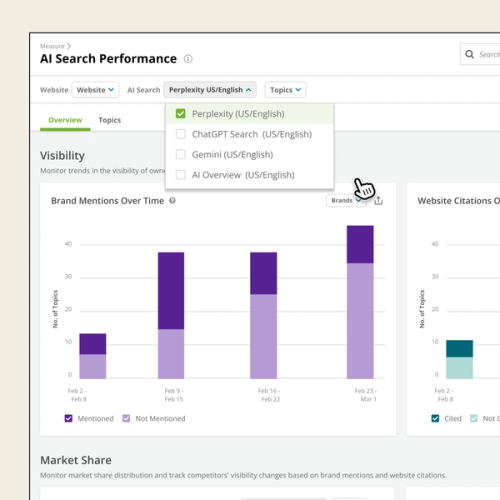
- Content brief creation: Creating thorough content briefs takes time that most SEOs or content marketers don't have, which is why AI automation in this step is so valuable. While basic AI can help outline content structure, Conductor's AI Writing Assistant takes this further by analyzing what's currently ranking for your target keywords or topics and providing specific optimization recommendations based on real SERP data—not just generic content suggestions.
- Featured snippets: AI tools can help you craft content specifically designed to capture featured snippet space from the competition. Using Conductor’s Content Guidance feature, you can identify keywords where you rank well but don’t own the featured snippet. Then, AI Writing Assistant can help you optimize that content with real-time suggestions based on what's actually working in search results, giving you a strategic advantage over generic AI approaches. Once you publish, watch the results come in, and make tweaks as needed.
- Internal & external link building: Ask your preferred AI model to “provide a list of the five best scholarly research articles about economic inflation.” And in just 10 seconds, you’ll have a list of great resources with citations to use in your content. You can also ask for specific types of sources like academic studies, industry reports, or expert opinions. For internal linking between your own pages, Conductor's Internal Link Suggestions functionality within Writing Assistant automatically suggests relevant internal links (and where to add them) based on your existing content.
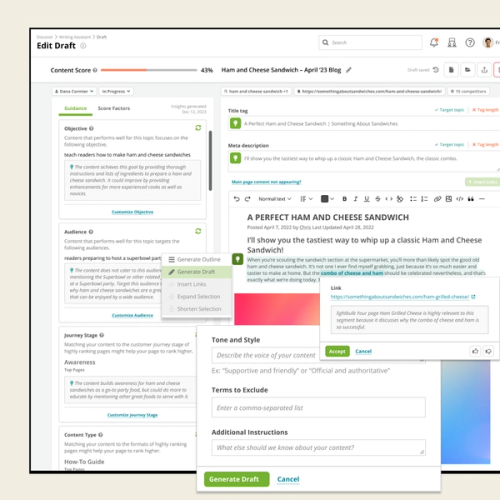
Content creation use cases
- Writing net new copy: At the risk of being repetitive, AI content generators can, indeed, write entire pieces of long or short-form content from scratch. You can prompt them for specific content types, audiences, or formats to get targeted results. However, this still requires human review to ensure the content aligns with search intent and brand voice. Conductor's Content Profiles allow you to integrate your brand guidelines, voice, and audience considerations into AI content creation, so generated drafts are aligned with your brand identity from the first word.
- Revising existing content: Hand-in-hand with creating new content is optimizing the content you already have. AI tools excel at this—It’s as simple as copying and pasting your content and specifying how it should be revised. Conductor's Content Score takes it even further by evaluating your content based on recommended objectives, structure, and real-time search and competitor data, so you can measure progress and optimize for impact before you publish.
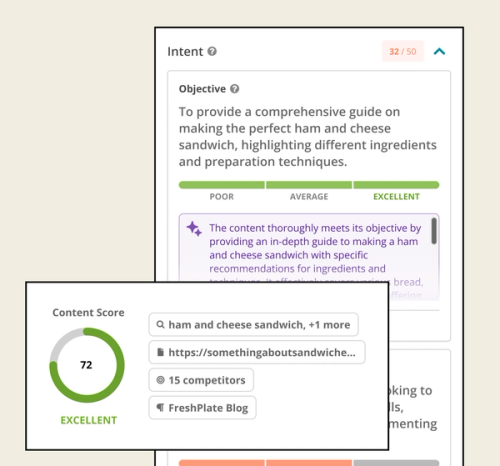
- Image generation: A natural evolution of AI writing content is using AI for design. There is no shortage of AI image generators out there that can help you optimize images and boost your designs. For example, tools like Gemini or ChatGPT can generate custom graphics from prompts, while others can remove an unwanted background from an image or improve image quality. These tools are great for creating unique visuals when stock photos won't cut it, but you'll still want to ensure images align with your brand guidelines and content strategy.
Technical use cases
- Coding and tag generation: AI content generators can even help you create rudimentary code for things like Schema markup, hreflang tags, and rules for robots.txt and redirects. Any SEO will tell you that these are, at best, tedious tasks that AI makes easy. Be sure to validate whatever the tool produces, though.
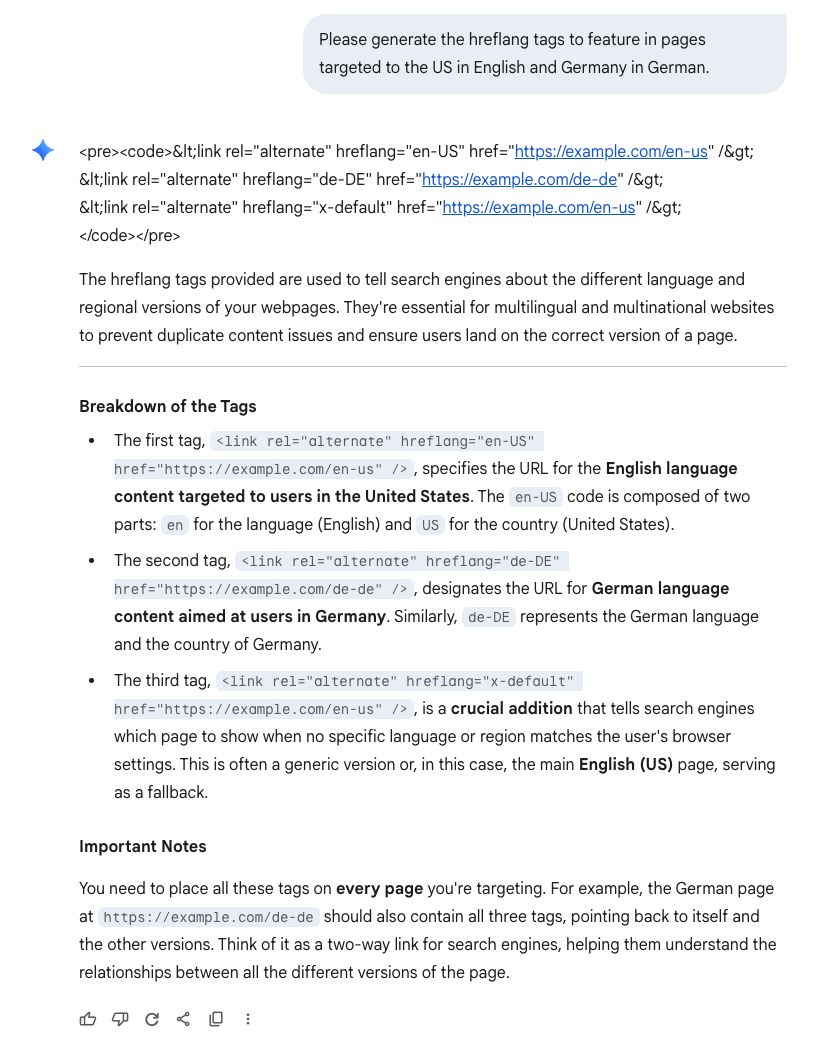
- Creating RegEx rules: RegEx refers to a specific sequence of characters that helps you find patterns within text. For example, you can use regex to find matches for a specific character or number, or the specific position of a piece of text. If you build out your regex rules enough, you can start to find very small needles, even in large haystacks of unordered data. To make this even more efficient, you can use ChatGPT, Claude, or Gemini to create regex rules for you and save time in tedious tasks. For instance, you can use rules in Google Search Console to filter queries containing a specific brand name, or find users who engaged with you through X (Twitter).
Miscellaneous use cases
- Summarizing YouTube transcripts: Another way that AI can be used in conjunction with a Chrome extension is to summarize video transcripts to save yourself time. The Chrome extension, Glasp , allows users to highlight and annotate content on websites. In addition, it offers multiple integrations with AI. Specifically, it can create summaries of texts based on your annotations, as well as show you the transcript for any YouTube video, which you can then copy and paste into any AI model to get a quick summary of the video.
- Generating training materials and tests: An extremely helpful workflow for any trainers or leaders welcoming new team members is using AI to create tests and training manuals. Anyone who has ever created materials to test someone knows how time-consuming and tedious it can be to think of questions and create an answer key. AI tools can automate this entire workflow—all you need to do is have a topic in mind. AI will take care of the rest.
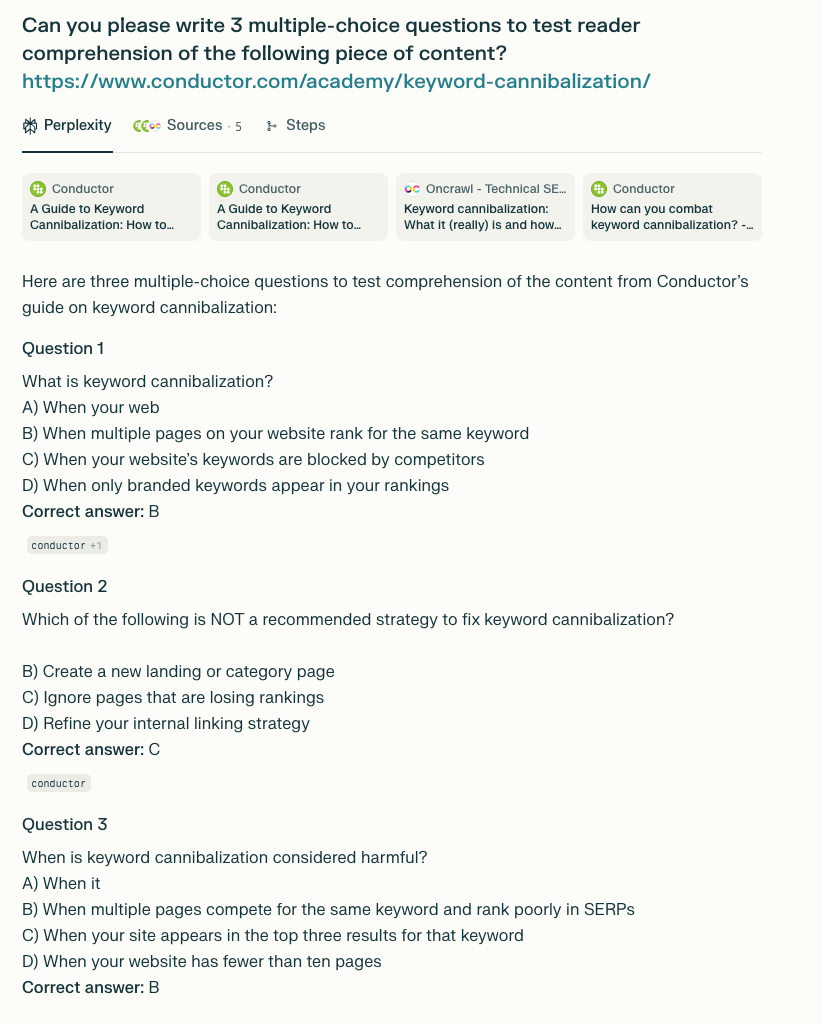
These workflows are just the beginning of what's possible when you integrate AI into your content strategy. The key is moving beyond one-off use cases to building systematic processes that actually scale with your team's needs.
Most content teams start with general AI tools for brainstorming and basic content creation. That's a smart first step, but it's just that—a first step. The real gains come when you graduate to platforms built specifically for the unique demands of website content optimization.
Summing it up
Here's what we've learned from working with hundreds of content teams: generic AI gets you generic results.
When creating website content that needs to rank and convert, you need more than what general-purpose tools can deliver. Website content optimization requires real-time SERP data, competitor analysis, search intent understanding, and performance measurement—all working together in one platform. It's the difference between content that gets published and content that gets results.
The teams seeing the biggest wins have moved beyond juggling multiple tools. Instead of piecing together generic AI, separate SEO tools, analytics platforms, and content generation systems, they've consolidated everything into one specialized platform built for website success.
Conductor combines AI-powered content creation with real-time search intelligence, competitor insights, and performance tracking in one platform. Create, optimize, and measure your content without switching between tools.



